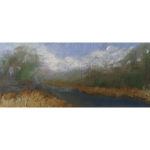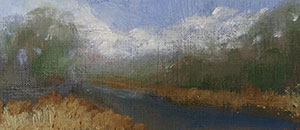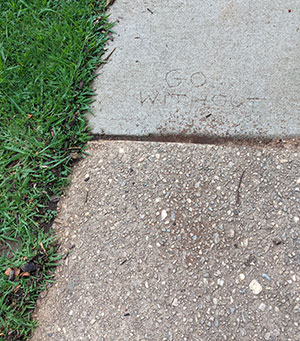The Joy and Struggle of Simplification

Why share the joy and struggle of simplification here? So many reasons to share today! Before I continue, I will welcome new readers to this blog and post. If you’re interested in learning more about the purpose of this place, take a look at this link here. Let’s get to the crux, the joy and the struggle of simplification, shall we?
The Introduction
Recently, an artist friend (you can read about this friend, aka Kathy #1, here in this post) recommended a class she took with Claudia Rilling. The minute I saw her artwork I signed up. Why? Well, first of all, her paintings immediately drew me in. The reason may be purely subjective? But I think her compositions are wonderful. And, I find I continue to look at her paintings for longer than a few minutes because of the texture and paint handling, too.
It has only been a day or two since the first class. And, as we are in 2022 here, this is an online class. But this instructor and painter absolutely practices and preaches simplification. How? Yes yes we painters know the secret to any good painting is…the start. Right? And, the best way toward a strong start is big, simple shapes. But, so far, Claudia Rilling paints with simplification at each and every step of the way. Read on to learn more!
Simplification Step 1
She uses a view finder to select her composition to paint outdoors. Before she starts her painting, she grabs a small square Post-It note. And she draws a simple quick thumbnail sketch. She puts that thumbnail on her easel. It acts as reminder of the big simple shapes she needs to paint. She squints, takes the biggest brush possible and blocks in the lightest and darkest shapes.
Step 2
To make sure she keeps shapes simple, she uses a palette knife at this next stage. Whoa! This is a really interesting idea. I have only been using the palette knife to create texture at the very end of my painting process.
You can see the texture I added to this week’s oil sketch. Yes I used a palette knife for this. It was fun!

I can’t wait to try the palette knife earlier in the painting process. This surely will force me to keep the existing shapes extremely simple.
Cosmic alignment
I love that the more I start to think about something in my painting practice, the more I see. It feels as if my mind is now actively searching for ways to simplify my paintings, brush strokes, compositions, everything I possibly do in the process.
In fact, I got a ‘concrete’ message about this during one of my morning walks with BDE (best dog ever) this week. Check out the message below:

Can you see the words etched just above the line of the sidewalk? Isn’t that cool?
Why is there a Struggle
I realize I would be remiss in my short discussion here about simplification if I didn’t share the struggle. Why is there a struggle? What can I do about it? Believe it or not, simplification in painting is the key to mastery. But whether you are painting a human being or a landscape, simplification is hard. Why else would a new landscape painter go after the leaves of a tree? And a new figure painter would first paint the eyes of person’s face? These tendencies are hard to break! The leaves and eyes are what we tend to think we see.
But to condense these complex scenes to an intriguing composition on a two-dimensional surface, simplification is essential. There are ways to achieve simplification as a painter. One way is to set a timer, paint quickly and stop when the timer goes off. Painters also can strive towards simplification by deciding to paint a painting with a certain number of strokes. For instance, say to myself, “I will paint this apple in 25 strokes.” Or, as Claudia Rilling would say, you can doggedly, intentionally paint everyday. And, sooner or later, you will make simplification a part of your process.
The goal is to become mindful of the material so that it’s use leads to a lovely painting with as little as possible. “Going without!” Right?
How About You
Well gentle reader, how about you? Is there a process that you are evaluating that warrants simplification? How will simplification help you? I would love to hear all about it in the comments below!

4 Comments
Beth Dyer Clary
July 14, 2022Does the “concrete” message (love that) say “Go without” or “Go with love”? I can’t quite make it out. Either one is cool and I suspect it’s “Go Without” based on the theme of the week and the synchronicity of things. Excellent!
And this class sounds amazing. Way to jump in and “complicate” ( 🙂 ) your life with yet another activity – seems to be the right thing!
Thinking about simplicity and simplifying is a near full-time preoccupation these days as life seems way too busy at the moment! Love any ideas from your followers so will check back!
Julie Holmes
July 20, 2022Hi Beth, Yes the concrete message is “Go Without.” Seems a bit redundant to suggest this after the deprivation and loss of the pandemic.
But you’re right synchronicity of this class and seeing this on a walk seemed to ‘align!’
Thanks as always for reading and commenting here! It’s always reassuring to get your insights! xoxoxoxo
Alexandra
July 16, 2022I really enjoyed the landscape you posted. It’s lovely – dreamy and impressionistic. Claudia Rilling’s process sounds interesting. I enjoy reading how artists get their ideas and start each painting. It demonstrates how much more methodical we artists are than people realize. I would even say that someone like Jackson Pollock who seemingly flung paint on a canvas willy-nilly had his own reasons and structure for the flinging. And, yes, the simplification and mindfulness you describe demonstrates the same kind of intentionality that helps make a good artist.
As for my own search for simplification, it has indeed been a lifelong struggle with the last few years marked by a mostly unsuccessful attempt to force my overactive brain to think as little as is humanly possible.
Julie Holmes
July 20, 2022Hi Alexandra,
Thanks for your thoughts about the landscape painting! I strive for dreamy and impressionistic in these paintings. So, yay, I’m glad you see it, too.
And, I agree that there is an actual process to these creative endeavors of ours. Eh? Most people seem to think that we can paint and create something when inspired. But, in fact, it’s so much more about showing up, doing a process and evaluating that process to see if it still works. That’s one of the reasons I am enjoying CR’s class. She’s clear with process and definitions. So we can try out what she does and then decide what works and what doesn’t.
As for your overactive brain, I say embrace it baby! It must be working its way into your beautiful paintings. And, we viewers are the beneficiaries of that! Carry on and xoxoxoxo!